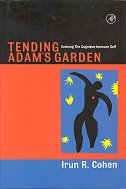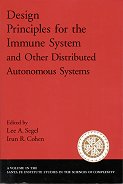This is a book of two halves, each of them excellent. Cohen is a
professional immunologist, and his reason for writing is to explain
his theory of the immune system as a
complex self-organising
cognitive system. But that's only the second half, because before he
does so, he takes the first half to explain complexity, evolution and
cognition. And that first half background is worth the entrance price
alone.
The immune system works by recognising and responding to
certain molecules and cells. Cohen's theory is that it has properties
of a cognitive system, so he needs to define recognition, reaction,
meaning, information, entropy, emergence, and so on. He does this all
very nicely. (And he has a rather nice way of describing evolution in
terms of attractors in a dynamical biological system, too.) His
definition of a cognitive system is one that has three properties:
- it contains internal images of its environment
- it self-organises by updating its internal images based
on its experience
- it makes decisions based on its internal state
[I would quibble with his usage of the term self-organisation
here, but not with the concept it is being used to label. I would
prefer to call this property learning, which fits with the
internal images being kinds of memories.] The important point
to note in this definition is that it makes no mention of anything
like consciousness, or even what we classically term as thinking.
Thus is can be applied to non-brain-like activities, in particular,
the immune system.
Having established a solid background in the first half of the book,
Cohen goes on to describe the amazingly complicated immune system, and
how it can be viewed as a cognitive system. He pays particular
attention to the seemingly paradoxical properties of degeneracy
(a receptor may bind to many different ligands), pleiotropia
(an agent may do different things in different contexts) and
redundancy (several different agents may perform the same action). He
shows how these non-specific properties can lead to highly specific
recognition and reaction, and why the resulting system has no simple
one-to-one relationship between cause and effect.
There is a very strong sense of process and dynamics
in this description. That life and other complex systems are not
static things but dynamic processes has become the
prevalent viewpoint over the last few decades, and helps to remove
some of the paradoxes that the static view threw up. Indeed, Cohen's
description is so process-oriented that he uses a form of
Harel State Charts to depict some of the
processes. [I would quibble slightly here too, because I think some of
the "states" in these diagrams are not actually states, but
things going through a series of states. However, the diagrams show
clearly what is meant, and are much more useful than pictures of
static things, or simplistic "lifecycle" pictures. Better
use of State Charts for these kind of models can be found in
Kam,
Cohen, & Harel, The Immune System as a Reactive System:
Modeling T Cell Activation with Statecharts.]
After describing his new cognitive theory of immunity, Cohen
contrasts is with the 50-year-old "standard model" of Clonal
Selection Theory (CST). He shows that this classical theory of
immunology is correct insofar as it goes, but that it does not go far
enough, and misses much of the picture. CST paints a picture of an
immune system that is dormant when the organism is well, which awakens
when infection strikes, deals with it, then switches off again. In
reality, the immune system is constantly active. In particular, CST
ignores the entire maintenance function of the immune system.
The immune system does not just detect and kill intruders; it aids in
repair and growth, too.
The last part of the book covers autoimmunity. Physiological
autoimmunity is the recognition of, and reaction to, "self".
When that reaction is inappropriate, there may be an autoimmunity
disease. CST predicts that normal physiological autoimmunity is
impossible, which is not the case. Physiological autoimmunity is
actually an important property of the immune system. Amongst other
things, immune system cells recognise the state of other immune system
cells, so can tell when they are responding to something -- and they
recognise maintenance molecules, in order to perform maintenance
tasks. The cognitive theory readily accommodates physiological
autoimmunity, and also explains the patterns of autoimmune disease
much better than does CST.
In closing, Cohen notes that our immune system evolved in a world
where we associated in sparse groups each of about 10 to 100 people,
with no sanitation and no old people, very unlike the sterile but
populous diverse world we live in today. The immune system needs to be
understood much better, for it needs all the help it can get,
operating so far from its evolutionary context. [This closing piece is
wrapped up in some biblical metaphor, which did nothing for me. But it
is just a metaphor, and the point being made stands alone.]
This is an excellent book, clearly written, with an interesting and
well-argued thesis. Even if you are not interested in immunology, read
the first half for the insights into meaning, evolution and cognition.
Then read the second half anyway, and become interested!
Overview
I read this book mostly on the train while commuting. It is so
packed with good ideas that I started carrying a little notebook with
me, to jot down references to the good lines. I reproduce below the
ones that caught my eye. These capture some of the
breadth and depth of the material Cohen covers. (The cross referencing
to other sections is useful, too. Rather than repeating a definition
several chapters later, or leaving you hunting through your fading
memory, a simple §nn in the text leads you to the original
definition.)
On causality, evolution and cognition
[§8]
information that causes some effect is
information that bears meaning. Meaning is the impact of information.
Meaning, in contrast to information, is extrinsic. Meaning is what the
information does.
[§41]
there are more E. coli
organisms in any one of us than there have been of humans in all the
world for all of time
[§41]
evolution is the creation and
occupation of attractors ...
The very existence of attractors ... makes new informational
space (new room) for more complex attractors to emerge. ... the
emergence of cells made room for the emergence of multicellular
organisms.
[§59]
Entities interact most naturally when
they occupy similar scales.
[§60]
Physiological systems ... are coded
images of the needs they have evolved to satisfy. ...
the inside of the glove is a negative image of the hand it fits
... The glove is also a more abstract image of the cold weather
... that is, evolved systems are coded images of the needs
they have evolved to satisfy; designed systems are coded
images of the needs they have been designed to satisfy. (Note the
essential change from active to passive voice.)
[§61]
cognitive machines ...
[construct] internal
images that map the environment.
[§69]
Internal images, like other
physiological properties of systems, can fail to develop, or may
function improperly
[§73]
The second condition for
self-organization ... is that there be extra, or redundant, copies of
the old information. ... if the old information were not redundant, it
would be destroyed in the process of transforming it into new
information.
... hence we are talking of "embodied", or physical,
information, not abstract information.
[§73]
If the protein does something,
participates in an attractor, then the information bears meaning. If
there is no functional protein (no attractor), there is no meaning.
... so, information has "meaning" if the information
receiver/bearer does something (participates in an attractor)
based on the meaning.
[§76]
experience can only be experience of
something. ... Unless you have a notion of what you are looking for,
you won't know it when you see it. Reality in itself is undivided; to
observe, the observer needs pre-formed categories that divide reality
into usable portions.
On immunity and autoimmunity
[§96]
Immune maintenance of the functioning
body, like the embryological building of the body, involves cell death
as well as cell growth, movement, and support functions
[§99]
recognition requires ... discrimination
and response. ... Recognition ... requires both information
and meaning.
[§101]
a protein can respond to a ligand by
changing its conformation when it binds the ligand. ... The reaction
site can have one distinct shape in the absence of a ligand and
another distinct shape when the combining site has bound (has sensed)
the ligand. This shift in conformation of the reaction site
constituted the physical response of the receptor ... Receptor-ligand
interactions can be viewed as attractors.
[§102]
The protein chain encoded by a single
DNA sequence can have more than one stable conformation (and hence
more than one function), and transitions between conformations are
determined by ligands and other environmental factors. By itself, the
DNA sequence does not suffice to determine the shape and function of
its protein; [they] emerge in response to interactions wit the
epigenetic environment.
[§103]
When asked to computer the conformation
of a protein based on its sequence, the computer flounders; there are
simply too many computations that need to be done. ... It is a wonder
how the protein, within seconds, folds itself into stable states of
potential energy. Obviously proteins ... do not have to compute their
steps one by one as they fold. But then how do they do it?
[§104]
Protein synthesis is inherently
hazardous ... because the contents of the cell could become exposed to
incomplete protein chains. [They] lack the amino acids they need for
their mature conformations and so might assume improper shapes and,
even worse, poison the cell
[§105]
A sufficiently flexible ligand ... can
mold itself to fit different receptors
The "lock and key" metaphor is too binary:
[§105]
affinity is a matter of degree.
alternative ligand can bind to the same receptor, so recognition
is not just binding, it must also include response:
[§105]
specificity is not a given
fidelity is a relative concept:
[§107]
Any receptor will bind to more than one
ligand, ... any ligand will be able to interact with more than one
receptor.
[§108]
pharmaceutical agents of all kinds work
as artificial [high affinity] ligands to activate or block receptors
that have evolved naturally to bind other [lower affinity] molecules
[§111]
You do not inherit the DNA genes that
encode your antigen receptors; you manufacture your own receptor genes
epigenetically from genetic raw materials.
[§111]
the epigenetic machinery of an
individual ... is able to produce about a millionfold more diversity
than does the germ-line of the species. Indeed, your immune system is
as rich in the potential diversity of its antigen receptors as is your
brain in the number of its nerve connections.
[§112]
biologic specificity cannot be reduced
to the chemistry and physics of ligand binding
[§119]
The immune system ... responds
simultaneously to different aspects of its target entities and to its
own responses to these target features.
...
Recognition ... emerges as a property of co-responding
populations of semi-independent agents.
[§124]
Complex
networking is the raw
material from which cognition emerges.
[§125]
all forms of life share molecular
similarities. The self is really not very different chemically from
its potential predators. ... Self-experience is the only experience
accessible to the immature immune system, and, fortunately, protection
can arise from self-experience.
[§126]
If the first selection led to T cells
with degenerate affinity for self, then the second selection leads to
T cells with higher affinity for altered self. ... the second
selection ... appears to focus on deviations from self.
[§128] Human
mothers transmit a sample of their antibodies to their children.
[via placental blood, and milk]
... These antibodies not only passively supply the newborn baby with
ready-made antibodies against environmental pathogens common to mother
and child, the maternal antibodies actively prime the immune system.
[§132]
A monoclonal population of antibodies
is intrinsically poor in ligand specificity because the population is
uniformly degenerate. Polyclonal antibodies tend to be much more
specific because each of the different antibodies features a different
pattern of degeneracy.
[§138]
the immune system connects the
experience of the species to the experience of the individual. Immune
interactions are an on-going association of somatic particulars with
germ-line classes of behaviour.
[§139]
Memory is another cognitive concept
whose mechanism is clearer in the immune system than it is in the
brain. Memory is the expression of learning from past experience.
Is there an immune system analogue of "false memory syndrome"?
[§139]
Memory is the replacement of a context
of infection by some antigens.
[§139]
Vaccination is a way to supply the
immune system with the experience it needs to learn an effective
response pattern to an agent of disease without incurring the actual
disease. ... the classroom lesson is never as effective as is real
experience on the street. ... That's why protection by way of
vaccination usually needs boosting.
[§148] [Autoimmune
disease] susceptibility genes
are prerequisites, not causes. ... most [identical]
twins are discordant (differ)
when it comes to expressing an autoimmune disease.
[§162]
the immune system of
[a Non-Obese Diabetic]
mouse, by practising on infectious
agents, can learn to become more adept at controlling its genetic
tendency towards autoimmune diabetes.
[§162]
The immune system, like the brain, needs
experience to self-organize.
[§163]
Immune responses to some infectious
agents have been shown actually to induce autoimmune diseases. A clear
example in humans is acute rheumatic fever...
[§163]
Reactive arthritis and possible other
infection-associated autoimmune diseases in humans are thought by some
to be triggered by self-antigen mimicry. ... the self-antigen becomes
confused with a persistent infection. ... Conflicting signals can
drive brains crazy and immune systems mad.
[§177]
There is no absolute antigenic
distinction between the self and the not-self; the immune system can
recognise and respond to either. ... the self, like life itself, is an
emergent property.
[§181]
creatures with complex tissues also
have complex immune systems. ... The plants and the invertebrates,
with their few and relatively simple tissue types, have populated the
earth and thrive to this day without the benefit of even a single
lymphocyte. An innate, germ-line immune system of macrophage-like
cells satisfies them completely.
[§181]
the complex composition of vertebrates
requires extreme maintenance. Complexity dazzles, but costs; simple
tissues and innate immune systems don't get cancer.
[§184]
The ever-increasing complexity of human
culture ... has created new opportunities for parasites and,
consequently, new challenges for the immune system.


